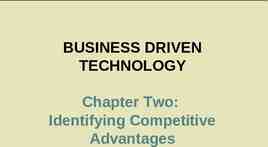Halliday/Resnick/Walker Fundamentals of Physics Classroom Response
35 Slides301.50 KB

Halliday/Resnick/Walker Fundamentals of Physics Classroom Response System Questions Chapter 29 Magnetic Fields Due to Currents Interactive Lecture Questions

29.2.1. The equation for the magnetic field of a straight, current 0i , but the magnetic field at the center 2 R 0i of a single closed circular loop is given by B . Although these 2R carrying wire is given by B equations look similar, there is an important difference between these two equations, other that the factor of . What is it? a) The µ0 factor is different for the two situations. b) The variable R represents two different lengths. c) The i represents two different types of current.

29.2.1. The equation for the magnetic field of a straight, current 0i , but the magnetic field at the center 2 R 0i of a single closed circular loop is given by B . Although these 2R carrying wire is given by B equations look similar, there is an important difference between these two equations, other that the factor of . What is it? a) The µ0 factor is different for the two situations. b) The variable R represents two different lengths. c) The i represents two different types of current.

29.2.2. Complete the following statement: The magnetic field around a current-carrying, circular loop is most like that of a) the Earth. b) a current-carrying, rectangular loop c) a short bar magnet. d) a long, straight, current-carrying wire. e) two long, straight wires that carry currents in opposite directions.

29.2.2. Complete the following statement: The magnetic field around a current-carrying, circular loop is most like that of a) the Earth. b) a current-carrying, rectangular loop c) a short bar magnet. d) a long, straight, current-carrying wire. e) two long, straight wires that carry currents in opposite directions.

29.3.1. Two parallel wires have currents that have the same direction, but differing magnitude. The current in wire A is i; and the current in wire B is 2i. Which one of the following statements concerning this situation is true? a) Wire A attracts wire B with half the force that wire B attracts wire A. b) Wire A attracts wire B with twice the force that wire B attracts wire A. c) Both wires attract each other with the same amount of force. d) Wire A repels wire B with half the force that wire B attracts wire A. e) Wire A repels wire B with twice the force that wire B attracts wire A.

29.3.1. Two parallel wires have currents that have the same direction, but differing magnitude. The current in wire A is i; and the current in wire B is 2i. Which one of the following statements concerning this situation is true? a) Wire A attracts wire B with half the force that wire B attracts wire A. b) Wire A attracts wire B with twice the force that wire B attracts wire A. c) Both wires attract each other with the same amount of force. d) Wire A repels wire B with half the force that wire B attracts wire A. e) Wire A repels wire B with twice the force that wire B attracts wire A.

29.3.2. Two parallel wires have currents that are in opposite directions and have differing magnitudes. The current in wire A is i; and the current in wire B is 2i. Which one of the following statements concerning this situation is true? a) Wire A attracts wire B with half the force that wire B attracts wire A. b) Wire A attracts wire B with twice the force that wire B attracts wire A. c) Both wires repel each other with the same amount of force. d) Wire A repels wire B with half the force that wire B attracts wire A. e) Wire A repels wire B with twice the force that wire B attracts wire A.

29.3.2. Two parallel wires have currents that are in opposite directions and have differing magnitudes. The current in wire A is i; and the current in wire B is 2i. Which one of the following statements concerning this situation is true? a) Wire A attracts wire B with half the force that wire B attracts wire A. b) Wire A attracts wire B with twice the force that wire B attracts wire A. c) Both wires repel each other with the same amount of force. d) Wire A repels wire B with half the force that wire B attracts wire A. e) Wire A repels wire B with twice the force that wire B attracts wire A.

29.3.3. The drawing represents a device called Roget’s Spiral. A coil of wire hangs vertically and its windings are parallel to one another. One end of the coil is connected by a wire to a terminal of a battery. The other end of the coil is slightly submerged below the surface of a cup of mercury. Mercury is a liquid metal at room temperature. The bottom of the cup is also metallic and connected by a wire to a switch. A wire from the switch to the battery completes the circuit. What is the behavior of this circuit after the switch is closed? a) When current flows in the circuit, the coils of the wire move apart and the wire is extended further into the mercury. b) Nothing happens to the coil because there will not be a current in this circuit. c) A current passes through the circuit until all of the mercury is boiled away. d) When current flows in the circuit, the coils of the wire move together, causing the circuit to break at the surface of the mercury. The coil then extends and the process begins again when the circuit is once again complete.

29.3.3. The drawing represents a device called Roget’s Spiral. A coil of wire hangs vertically and its windings are parallel to one another. One end of the coil is connected by a wire to a terminal of a battery. The other end of the coil is slightly submerged below the surface of a cup of mercury. Mercury is a liquid metal at room temperature. The bottom of the cup is also metallic and connected by a wire to a switch. A wire from the switch to the battery completes the circuit. What is the behavior of this circuit after the switch is closed? a) When current flows in the circuit, the coils of the wire move apart and the wire is extended further into the mercury. b) Nothing happens to the coil because there will not be a current in this circuit. c) A current passes through the circuit until all of the mercury is boiled away. d) When current flows in the circuit, the coils of the wire move together, causing the circuit to break at the surface of the mercury. The coil then extends and the process begins again when the circuit is once again complete.

29.3.4. Three very long, parallel wires (a small portion of each is shown in the drawing) are resting on a flat surface. The distance between wire B, which has a 15 mA current to the left, and its neighbors is 0.0015 m. Wire A carries a 10 mA current toward the right; and wire C carries a 5 mA current toward the right. Rank the wires in order of the magnitude of the net magnetic force on each, with the largest value first and the lowest value last. a) A B C b) B A C c) C B A d) A C B e) B C A

29.3.4. Three very long, parallel wires (a small portion of each is shown in the drawing) are resting on a flat surface. The distance between wire B, which has a 15 mA current to the left, and its neighbors is 0.0015 m. Wire A carries a 10 mA current toward the right; and wire C carries a 5 mA current toward the right. Rank the wires in order of the magnitude of the net magnetic force on each, with the largest value first and the lowest value last. a) A B C b) B A C c) C B A d) A C B e) B C A

29.4.1. A copper cylinder has an outer radius 2R and an inner radius of R and carries a current i. Which one of the following statements concerning the magnetic field in the hollow region of the cylinder is true? a) The magnetic field within the hollow region may be represented as concentric circles with the direction of the field being the same as that outside the cylinder. b) The magnetic field within the hollow region may be represented as concentric circles with the direction of the field being the opposite as that outside the cylinder. c) The magnetic field within the hollow region is parallel to the axis of the cylinder and is directed in the same direction as the current. d) The magnetic field within the hollow region is parallel to the axis of the cylinder and is directed in the opposite direction as the current. e) The magnetic field within the hollow region is equal to zero tesla.

29.4.1. A copper cylinder has an outer radius 2R and an inner radius of R and carries a current i. Which one of the following statements concerning the magnetic field in the hollow region of the cylinder is true? a) The magnetic field within the hollow region may be represented as concentric circles with the direction of the field being the same as that outside the cylinder. b) The magnetic field within the hollow region may be represented as concentric circles with the direction of the field being the opposite as that outside the cylinder. c) The magnetic field within the hollow region is parallel to the axis of the cylinder and is directed in the same direction as the current. d) The magnetic field within the hollow region is parallel to the axis of the cylinder and is directed in the opposite direction as the current. e) The magnetic field within the hollow region is equal to zero tesla.

29.4.2. The drawing shows two long, thin wires that carry currents in the positive z direction. Both wires are parallel to the z axis. The 50-A wire is in the x-z plane and is 5 m from the z axis. The 40-A wire is in the y-z plane and is 4 m from the z axis. What is the magnitude of the magnetic field at the origin? a) zero tesla b) 1 10 6 T c) 3 10 6 T d) 5 10 6 T e) 7 10 6 T

29.4.2. The drawing shows two long, thin wires that carry currents in the positive z direction. Both wires are parallel to the z axis. The 50-A wire is in the x-z plane and is 5 m from the z axis. The 40-A wire is in the y-z plane and is 4 m from the z axis. What is the magnitude of the magnetic field at the origin? a) zero tesla b) 1 10 6 T c) 3 10 6 T d) 5 10 6 T e) 7 10 6 T

29.4.3. The drawing shows two long, straight wires that are parallel to each other and carry a current of magnitude i toward you. The wires are separated by a distance d; and the centers of the wires are a distance d from the y axis. Which one of the following expressions correctly gives the magnitude of the total magnetic field at the origin of the x, y coordinate system? 0i a) 2d b) 0i 2d c) 0i 2 d d) 0i d e) zero tesla

29.4.3. The drawing shows two long, straight wires that are parallel to each other and carry a current of magnitude i toward you. The wires are separated by a distance d; and the centers of the wires are a distance d from the y axis. Which one of the following expressions correctly gives the magnitude of the total magnetic field at the origin of the x, y coordinate system? 0i a) 2d b) 0i 2d c) 0i 2 d d) 0i d e) zero tesla

29.5.1. The drawing shows a rectangular wire loop that has one side passing through the center of a solenoid. Which one of the following statements describes the force, if any, that acts on the rectangular loop when a current is passing through the solenoid. a) The magnetic force causes the loop to move upward. b) The magnetic force causes the loop to move downward. c) The magnetic force causes the loop to move to the right. d) The magnetic force causes the loop to move to the left. e) The loop is not affected by the current passing through the solenoid or the magnetic field resulting from it.

29.5.1. The drawing shows a rectangular wire loop that has one side passing through the center of a solenoid. Which one of the following statements describes the force, if any, that acts on the rectangular loop when a current is passing through the solenoid. a) The magnetic force causes the loop to move upward. b) The magnetic force causes the loop to move downward. c) The magnetic force causes the loop to move to the right. d) The magnetic force causes the loop to move to the left. e) The loop is not affected by the current passing through the solenoid or the magnetic field resulting from it.

29.5.2. An initially unmagnetized iron bar is placed next to a solenoid. Which one of the following statements describes the iron bar after the solenoid is connected to the battery? a) A magnetic force accelerates the bar to the right. b) Since the bar is unmagnetized, there will not be any affect on the bar. c) The magnetic field of the solenoid will cause a current to flow in a loop that extends from one end of the bar to the other and that continues until the battery is disconnected from the solenoid. d) The magnetic field of the solenoid induces magnetism in the bar with the bar’s north pole nearest to the solenoid. e) The magnetic field of the solenoid induces magnetism in the bar with the bar’s south pole nearest to the solenoid.

29.5.2. An initially unmagnetized iron bar is placed next to a solenoid. Which one of the following statements describes the iron bar after the solenoid is connected to the battery? a) A magnetic force accelerates the bar to the right. b) Since the bar is unmagnetized, there will not be any affect on the bar. c) The magnetic field of the solenoid will cause a current to flow in a loop that extends from one end of the bar to the other and that continues until the battery is disconnected from the solenoid. d) The magnetic field of the solenoid induces magnetism in the bar with the bar’s north pole nearest to the solenoid. e) The magnetic field of the solenoid induces magnetism in the bar with the bar’s south pole nearest to the solenoid.

29.5.3. Which one of the following statements concerning the magnetic field inside (far from the surface) a long, currentcarrying solenoid is true? a) The magnetic field is zero. b) The magnetic field is non-zero and nearly uniform. c) The magnetic field is independent of the number of windings. d) The magnetic field is independent of the current in the solenoid. e) The magnetic field varies as 1/r as measured from the solenoid axis.

29.5.3. Which one of the following statements concerning the magnetic field inside (far from the surface) a long, currentcarrying solenoid is true? a) The magnetic field is zero. b) The magnetic field is non-zero and nearly uniform. c) The magnetic field is independent of the number of windings. d) The magnetic field is independent of the current in the solenoid. e) The magnetic field varies as 1/r as measured from the solenoid axis.

29.5.4. A solenoid of length 0.250 m and radius 0.0200 m is comprised of 120 turns of wire. Determine the magnitude of the magnetic field at the center of the solenoid when it carries a current of 15.0 A. a) 9.05 10-3T b) 7.50 10-3 T c) 4.52 10-3 T d) 2.26 10-3 T e) zero tesla

29.5.4. A solenoid of length 0.250 m and radius 0.0200 m is comprised of 120 turns of wire. Determine the magnitude of the magnetic field at the center of the solenoid when it carries a current of 15.0 A. a) 9.05 10-3 T b) 7.50 10-3 T c) 4.52 10-3 T d) 2.26 10-3 T e) zero tesla

29.5.5. A solenoid carries current I as shown in the figure. If the observer could “see” the magnetic field inside the solenoid, how would it appear?

29.5.5. A solenoid carries current I as shown in the figure. If the observer could “see” the magnetic field inside the solenoid, how would it appear?

29.5.6. A wire, connected to a battery and switch, passes through the center of a long current-carrying solenoid as shown in the drawing. When the switch is closed and there is a current in the wire, what happens to the portion of the wire that runs inside of the solenoid? a) There is no effect on the wire. b) The wire is pushed downward. c) The wire is pushed upward. d) The wire is pushed toward the left. e) The wire is pushed toward the right.

29.5.6. A wire, connected to a battery and switch, passes through the center of a long current-carrying solenoid as shown in the drawing. When the switch is closed and there is a current in the wire, what happens to the portion of the wire that runs inside of the solenoid? a) There is no effect on the wire. b) The wire is pushed downward. c) The wire is pushed upward. d) The wire is pushed toward the left. e) The wire is pushed toward the right.

29.5.7. A single circular loop of wire with radius 0.020 m carries a current of 8.0 A is placed at the center of a solenoid that has length 0.65 m, radius 0.080 m, and 1400 turns. Determine the value of the current in the solenoid so that the magnetic field at the center of the loop is zero tesla. a) 1.4 10 1 A b) 2.5 10 4 A c) 4.4 10 2 A d) 5.0 10 3 A e) 9.3 10 2 A

29.5.7. A single circular loop of wire with radius 0.020 m carries a current of 8.0 A is placed at the center of a solenoid that has length 0.65 m, radius 0.080 m, and 1400 turns. Determine the value of the current in the solenoid so that the magnetic field at the center of the loop is zero tesla. a) 1.4 10 1 A b) 2.5 10 4 A c) 4.4 10 2 A d) 5.0 10 3 A e) 9.3 10 2 A

29.5.8. The drawing shows a toroid that has an inner radius of 0.040 m and an outer radius of 0.060 m. The toroid is composed of 120 turns and carries a constant current of 0.50 A. What is the magnetic field at the center of the toroid, where r 0? a) zero tesla b) 1.2 10 5 T c) 2.3 10 3 T d) infinity e) This cannot be determined without more information.

29.5.8. The drawing shows a toroid that has an inner radius of 0.040 m and an outer radius of 0.060 m. The toroid is composed of 120 turns and carries a constant current of 0.50 A. What is the magnetic field at the center of the toroid, where r 0? a) zero tesla b) 1.2 10 5 T c) 2.3 10 3 T d) infinity e) This cannot be determined without more information.






